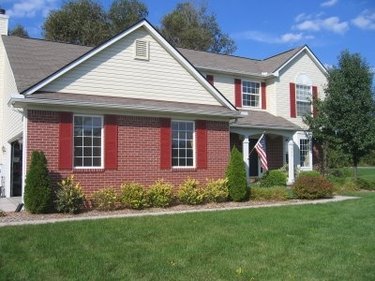
Vinyl can be painted and is typically a better surface for adhesion than wood or metal. Wood can crack and degrade and metal can rust, but vinyl remains stable. Painting vinyl siding, shutters and trim is easy with the right paint. You'll get the best results if you consider not only the type of paint but the sheen as well.
Assess the Surface
Video of the Day
Vinyl siding and shutters are prone to chalking over time as the surface oxidizes. Paint will not adhere to a chalky surface. To check for chalking, choose a spot on the sunniest side of your home and run the palm of your hand over the siding. If a white, chalky residue comes off on your hand, the siding needs to be scrubbed clean. Mildew can be removed with a 50/50 mixture of bleach and water. Rinse thoroughly and let it dry before painting.
Video of the Day
Vinyl siding and shutters do not need to be primed as long as you use the appropriate paint. Two coats will give you better durability and color retention than one coat.
Vinyl gutters, window frames and door trim are often harder and shinier than the vinyl used for siding and shutters. It needs to be cleaned and primed with a bonding primer before painting.
Choose the Best Paint
The best paint for vinyl is water-based 100 percent acrylic paint, or urethane-modified acrylic paint. Avoid lower-cost latex paint. Acrylic paint remains very flexible. Vinyl can expand and contract significantly with temperature changes, and lower quality paint will crack and peel under the stress.
Avoid alkyd (oil-based) paints. Like low-quality latex, they are not supple and flexible enough to withstand the contraction and expansion of vinyl siding. Alkyd paint may be acceptable for rigid window and door trim, but is harder to work with and takes longer to dry than acrylic paint.
For extra insurance against peeling paint, use a paint conditioner (see Resources). Not only are some formulated to help paint stick to hard-to-paint surfaces, the right paint conditioner will also make the paint flow better and provide a more uniform finish.
Consider Color and Sheen
Vinyl is made of pigmented plastic and can get very hot in direct sunlight. This is why it is typically available only in lighter colors. Vinyl that comes from the factory in dark colors is formulated to be sturdier and more durable. The rule of thumb when painting exterior vinyl is to paint it no darker than the original color. White siding may be painted light pastel shades. Using a dark color on light vinyl can cause it to buckle and warp in direct sunlight. Dark-colored houses can also affect your utility bill because the siding absorbs more heat.
Higher sheens, like semi-gloss and high gloss, are somewhat harder and more washable than flatter paints, but they will reflect light and accentuate surface irregularities. Bear in mind that a quality flat acrylic exterior paint is not truly flat. Acrylic paint contains enough solids that even "flat" formulas have a very subtle sheen, They are washable and durable.